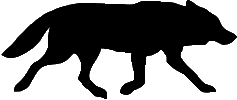Biology
Signs of presence
In an area frequented by wolves it is possible to identify both direct and indirect signs of its presence. Sighting, photographing, finding a carcass are direct signs of presence, which are quite unequivocal, but difficult to obtain.
For a highly elusive species such as the wolf, who travels over wide areas, it is easier to look for indirect signs of presence, such as footprints and droppings, often laid down in the characteristic marking points. Since a single footprint cannot be assigned to the wolf or to a dog of similar size, it is more appropriate to refer to the actual tracks, which can be seen on the snow, on muddy stretches, or in particular conditions on the foreshore, for the packs frequenting the coasts.
Researchers can study wolf’s tracks to obtain more information, such as the number of existing animals or their behaviour. The droppings instead are typical, with undigested remains of the carcasses that the wolves have eaten, such as hair, bones, nails and they have a distinctive smell. They can’t be easily distinguished without specific genetic analysis just from the ones of dogs feeding on similar food.
The wolves also use urine and faeces to mark the territory and therefore it is easy to find them on the path; and usually close to them you will also notice evident scratches that the wolf does with its hind paws, still with the purpose of signaling its presence.
History
Monitoring techniques
It is not easy to study and to monitor in the wild an elusive and intelligent animal like the wolf.
Since the 70s, various techniques have been tested and used in Italy. Among these we find the wolf-howling, which consists in emitting recorded howls through the loudspeaker, thus provoking a reply from the wolves. This technique also allows, in the summer months, to verify the reproduction of a pack, as it is possible to recognize the voices of the puppies in the group.
It is a rather invasive technique, so it should be used appropriately and in the context of technical monitoring. Another technique is snow-tracking, which is done by tracing the tracks that the wolves leave on the snow.
Typically, when the wolf moves in a pack, each individual places the paw in the footprint left by the companion before him, creating a unique and rectilinear trace.
The trace interrupts when there are obstacles or curves or when the group stops, and in this case it is possible to estimate the size of the pack.
An effective but more complex monitoring technique is the application of a GPS radio collar to a wolf. This implies the capture of the specimen (through harmless traps specially prepared with no human olfactory traces and then well positioned), its sedation, and the following release of the wolf with a collar recording its position through the satellites, and sending them in real time to researchers.
It is a type of activity that must be necessarily supported by the collaboration of biologists and veterinary doctors.
